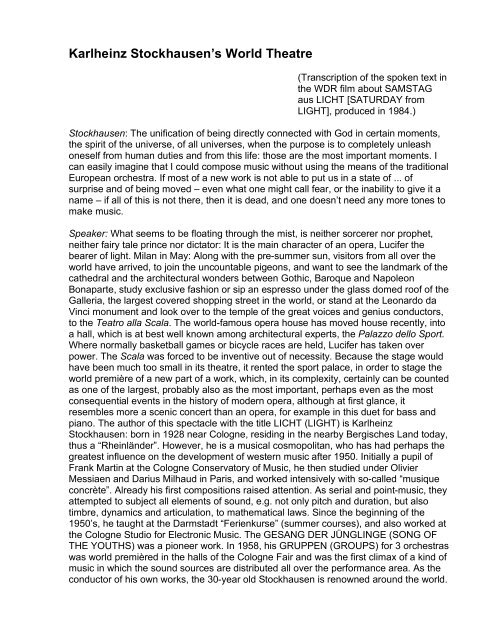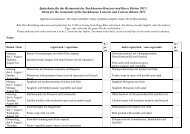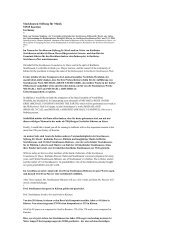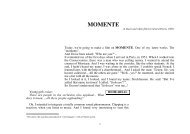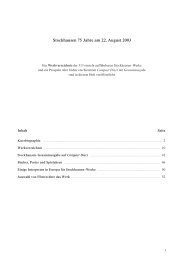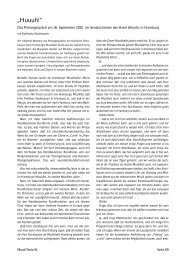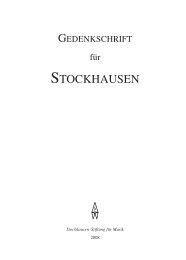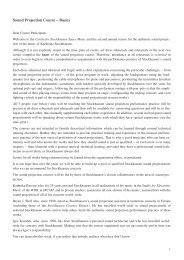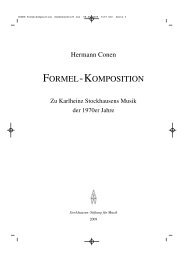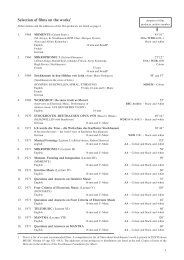Karlheinz Stockhausen's World Theatre
Karlheinz Stockhausen's World Theatre
Karlheinz Stockhausen's World Theatre
Create successful ePaper yourself
Turn your PDF publications into a flip-book with our unique Google optimized e-Paper software.
<strong>Karlheinz</strong> Stockhausen’s <strong>World</strong> <strong>Theatre</strong><br />
(Transcription of the spoken text in<br />
the WDR film about SAMSTAG<br />
aus LICHT [SATURDAY from<br />
LIGHT], produced in 1984.)<br />
Stockhausen: The unification of being directly connected with God in certain moments,<br />
the spirit of the universe, of all universes, when the purpose is to completely unleash<br />
oneself from human duties and from this life: those are the most important moments. I<br />
can easily imagine that I could compose music without using the means of the traditional<br />
European orchestra. If most of a new work is not able to put us in a state of ... of<br />
surprise and of being moved – even what one might call fear, or the inability to give it a<br />
name – if all of this is not there, then it is dead, and one doesn’t need any more tones to<br />
make music.<br />
Speaker: What seems to be floating through the mist, is neither sorcerer nor prophet,<br />
neither fairy tale prince nor dictator: It is the main character of an opera, Lucifer the<br />
bearer of light. Milan in May: Along with the pre-summer sun, visitors from all over the<br />
world have arrived, to join the uncountable pigeons, and want to see the landmark of the<br />
cathedral and the architectural wonders between Gothic, Baroque and Napoleon<br />
Bonaparte, study exclusive fashion or sip an espresso under the glass domed roof of the<br />
Galleria, the largest covered shopping street in the world, or stand at the Leonardo da<br />
Vinci monument and look over to the temple of the great voices and genius conductors,<br />
to the Teatro alla Scala. The world-famous opera house has moved house recently, into<br />
a hall, which is at best well known among architectural experts, the Palazzo dello Sport.<br />
Where normally basketball games or bicycle races are held, Lucifer has taken over<br />
power. The Scala was forced to be inventive out of necessity. Because the stage would<br />
have been much too small in its theatre, it rented the sport palace, in order to stage the<br />
world première of a new part of a work, which, in its complexity, certainly can be counted<br />
as one of the largest, probably also as the most important, perhaps even as the most<br />
consequential events in the history of modern opera, although at first glance, it<br />
resembles more a scenic concert than an opera, for example in this duet for bass and<br />
piano. The author of this spectacle with the title LICHT (LIGHT) is <strong>Karlheinz</strong><br />
Stockhausen: born in 1928 near Cologne, residing in the nearby Bergisches Land today,<br />
thus a “Rheinländer”. However, he is a musical cosmopolitan, who has had perhaps the<br />
greatest influence on the development of western music after 1950. Initially a pupil of<br />
Frank Martin at the Cologne Conservatory of Music, he then studied under Olivier<br />
Messiaen and Darius Milhaud in Paris, and worked intensively with so-called “musique<br />
concrète”. Already his first compositions raised attention. As serial and point-music, they<br />
attempted to subject all elements of sound, e.g. not only pitch and duration, but also<br />
timbre, dynamics and articulation, to mathematical laws. Since the beginning of the<br />
1950’s, he taught at the Darmstadt “Ferienkurse” (summer courses), and also worked at<br />
the Cologne Studio for Electronic Music. The GESANG DER JÜNGLINGE (SONG OF<br />
THE YOUTHS) was a pioneer work. In 1958, his GRUPPEN (GROUPS) for 3 orchestras<br />
was world premièred in the halls of the Cologne Fair and was the first climax of a kind of<br />
music in which the sound sources are distributed all over the performance area. As the<br />
conductor of his own works, the 30-year old Stockhausen is renowned around the world.
In the mid-1960’s, he studied far-eastern art and religion. At the <strong>World</strong> Fair in Osaka, he<br />
performed his own music 5 1/2 hours daily, six months long, for a total of almost one<br />
million listeners.<br />
Interviewer: There have been several phases in your work, in which your music has<br />
had a stronger objective character, so to speak, than it has today, if I see that correctly.<br />
Stockhausen: That is not correct. I have always felt music, primarily with each new work,<br />
as a vision, and I have only been interested in a new piece, if I have heard and seen<br />
something – inwardly – that was completely new and fascinating for me, and then a<br />
mental process of construction followed, and that is the same today. This mental<br />
process of construction is a process of copying my imagination as flawlessly as possible,<br />
or one could say the reduction of my imagination to the means, to the instrumental<br />
world, that now exists, which, for the most part, I must even completely unexpectedly<br />
expand, in order to somehow come closer to what I imagine. The entire electronic music<br />
that I have composed is nothing but the attempt to realise sound-worlds in the<br />
environment of traditional mechanical instruments that come closer to these inward<br />
sound visions, and which again, fascinated me.<br />
Speaker: Having to expand the existing sound possibilities, an inner motivation to invent<br />
something that does not yet exist, but has been heard by the inner ear. 1 This is the basic<br />
situation of the composer, <strong>Karlheinz</strong> Stockhausen, also in the conception of a new<br />
piece, that, among other things, includes a skeleton dance with the piccolo as the solo<br />
instrument. The orchestra is an instrumental ensemble that is very popular in America<br />
and which plays all kinds of music: from the entertainment at football games and public<br />
election events, to avant-garde chamber music, the Symphony Band. This particular<br />
orchestra comes from the University of Michigan at Ann Arbor. For his opera,<br />
Stockhausen divided it into ten groups, each with its own timbre and its own<br />
characteristic rhythms.<br />
The dancing Death, a mystical vision as a scenic expression of a musical phenomenon.<br />
The inward necessity of a renewal of sound. In addition, one must understand<br />
Stockhausen’s second basic prerequisite: his religious conviction that by far surpasses<br />
the Christian-occidental understanding of God.<br />
Stockhausen: Originally, I always had a single vision of GOD, of a godly being, while<br />
praying several times a day, and very often in short fervent prayers – independent of<br />
where it was, ever since I became conscious as a small child. And I have sometimes<br />
described it, that I saw myself on ... on a step of an endless staircase, and there was a<br />
completely white light, into which I couldn’t look, and I knew, GOD is there, and I was not<br />
in GOD, in the body – as an atom in a large body, the feeling that I have for example<br />
when I feel that I have integrated myself correctly, that I am suddenly inside, that I<br />
myself am a part, a very small part of GOD. That follows along parallel and has further<br />
developed with my consciousness of my guardian angel, who stands directly behind<br />
me and who immediately functions when I say: “You take over. Please do this. I cannot.”<br />
This hierarchy was supplemented in 1977 by the figure of MICHAEL, of whom I had not<br />
been aware until then. It came gradually, and it joined in with the traditional world of<br />
pictures and thoughts surrounding Christ, a historical figure, with Michael, the creator of<br />
1 Refers to the 3 rd scene, LUZIFERs TANZ (Lucifer’s Dance), of SAMSTAG aus LICHT (Saturday from Light)
our local universe, and that both of them are integrated with each other and have<br />
become one for me now, that is the figure of Christ was an emanation of Michael.<br />
Because Michael put himself into one of the lowest creatures of his universe, in order to<br />
deliver the message how one can escape Lucifer’s rebellion by himself. Sometimes, in<br />
particular moments, Michael is my partner, and I speak to him personally.<br />
The unification of being directly connected with God in certain moments, the spirit<br />
of the universe, of all universes, when the purpose is to completely unleash oneself from<br />
human duties and from this life: those are the most important moments.<br />
Speaker: The spirit of our universe as white light makes the title of the complete new<br />
work comprehensible: LICHT (LIGHT), a world theatre, a mysterious play about human<br />
life and its main question: “What is the purpose of existence in this universe?”<br />
A play in seven parts, named after the seven days of the week. Each of these<br />
days, according to its name, is associated with particular planets and the spiritual<br />
powers connected with them. The Moon-Day, the Mars-Day, the Mercury- or Wotan’s<br />
Day, the Donar- or Jupiter-Day, the Day of Freia and Venus, Saturday as Saturn-Day or<br />
Lucifer-Day, Sunday as the Sun-Day.<br />
Three main characters are present throughout the cycle:<br />
First, MICHAEL, Mikael – the face of God, as he is called in the earliest sources –<br />
the creator of our local universe, also of our Milky Way galaxy. In the opera, he is partly<br />
danced, partly sung or personified by a trumpeter. The extremely virtuoso trumpet part is<br />
played by Stockhausen’s son, Markus.<br />
Michael voices his own understanding of his role in a phase of the opera segment<br />
DONNERSTAG (Thursday), when he sings: “I became a human to see myself and God<br />
the father as a human vision, to bring celestial music to humans and human music to the<br />
celestial beings, so that Man may listen to God and God may hear his children”.<br />
The second main character: EVA (EVE), the spirit who always cares for the<br />
improvement of the physical conditions of the living beings on the planet. She is sung,<br />
danced or played (usually on the basset horn, or here in a transformation on the flute).<br />
The third character: LUZIFER (LUCIFER). Lucifer is played by a trombonist or<br />
danced (as here) by a dancer on stilts, and sung by a bass or baritone singer, until now,<br />
by Matthias Hölle.<br />
The seven stations of the world theatre, the seven operas of the LICHT-cycle, will<br />
show: MONTAG (MONDAY), the Eve-day, is the day of reincarnation of a new mankind.<br />
On DIENSTAG (TUESDAY), Lucifer and Michael will carry out an intellectual conflict. On<br />
MITTWOCH (WEDNESDAY), the three search for a world in which everyone<br />
understands each other. DONNERSTAG (THURSDAY), world premièred three years<br />
ago, showed how Michael became a human being and his travels around the Earth. On<br />
FREITAG (FRIDAY), Lucifer will try to convince Eva to join his rebellion. After<br />
SAMSTAG, the Lucifer-day, SONNTAG (SUNDAY) will make the reincarnation of man<br />
possible after the mystical unification of Michael and Eva.<br />
Stockhausen: Lucifer is often portrayed as an angel of light in a very ugly way. In my<br />
imagination (and in many pictures that I have had on my desk for years, which friends<br />
have sent me), Lucifer looks like an angel of light, like a wonderful being. Even when he<br />
is painted as a human figure, he is one of the most beautiful that one can find among the<br />
portrayals of the great artists. Lucifer called out a rebellion, demanded self-government<br />
of the planet, self-administration and secession from the central administration of the<br />
universe. And Lucifer openly claimed in his resolutions, that the idea of a God-Father, of
one single spirit of the universe, is a phantom, because no one has ever seen this<br />
Father, and the children of paradise had invented this concept to fool the living beings:<br />
this is therefore Lucifer’s rebellious idea.<br />
Speaker: And the opera SAMSTAG, that was world-premièred in Milan in Luca<br />
Ronconi’s production, concentrates once again in a very subtle way on this light-bearer<br />
and the consequences of his rebellion.<br />
In the first scene Lucifer dreams of a new kind of music. Lucifer would like to have<br />
a new piano piece, so he calls a pianist in, Majella, <strong>Karlheinz</strong> Stockhausen’s daughter.<br />
She is to play him a piece, as he says, in “five time-layers of increasing compression of<br />
figures..., extensions and pauses to nullify time.” So, Lucifer takes a seat on floating<br />
chair, listens to and enjoys the music he dreams, music that is no longer related to<br />
humans, but rather enchants the elements.<br />
What Lucifer hears here is, however, an independent concert piece,<br />
KLAVIERSTÜCK XIII, that easily fits into the series of existing twelve piano pieces<br />
<strong>Karlheinz</strong> Stockhausen has already composed. A piece that demands all modern<br />
pianistic virtuosity as well as quite a few distortion techniques. By shooting off little<br />
rockets at hated mankind, Lucifer’s ideology is again realised.<br />
Whether the unfamiliar playing methods or the far from human sounds, Lucifer<br />
enjoys them, defends himself, lets himself be enchanted, dies slowly. Can Lucifer die,<br />
does he really die?<br />
Majella has fulfilled her task, and so she returns to the unknown depths, from<br />
which her master had called her. However, and this becomes the second scene of the<br />
opera, Lucifer listens to a Requiem, sung by Eva, who has slipped into the figure of a<br />
flute-playing cat, played by the Dutch virtuoso Kathinka Pasveer, after whom this scene<br />
was also named, KATHINKAs GESANG (KATHINKA’S CHANT).<br />
With her singing, Kathinka protects the souls of the dead from temptations and<br />
leads them to clear consciousness. She is accompanied by six percussionists, the<br />
mortal senses, who react to KATHINKAs GESANG with their home-made magic<br />
instruments. This chant has 24 stages. The elements are portrayed on a round mandala<br />
like the numbers on a clock. When Kathinka has fulfilled her task, she must, like Majella,<br />
return to the depths. She disappears down into a dark grave in the shape of a grand<br />
piano.<br />
But is she even able to sing a requiem for Lucifer? Can she lead his soul to an<br />
even clearer consciousness? In the depth of the grave, the answer is waiting for<br />
Kathinka, and it is shocking. Lucifer is alive, rises up out of the grave, amused and<br />
ridiculing. Was he not really dead? Has he risen from the dead? Reincarnated?<br />
<strong>Karlheinz</strong> Stockhausen’s philosophy about human existence goes beyond our familiar<br />
views and beliefs, but refers to respectable witnesses between Plato and Sri Aurobindo.<br />
Stockhausen: Yes, I don’t haven’t any particular thoughts of my own on that – or, none<br />
at all, but very much has been written, told, passed on by people who tell how one<br />
incarnates into a human body and how one goes through his own school as a human<br />
being in a particular milieu; how one chooses a certain activity, or several, for this very<br />
short time, and how one prepares for the departure from the body. What one can do to<br />
correctly prepare for this moment of farewell and new beginning, and that one then, for a<br />
certain amount of time determined by one’s own will and behaviour, may either remain<br />
in a physical form indescribable by our human imagination as a spiritual being, or<br />
completely abandons the idea of needing a body defined by space and time. Thus, this
passage of life has been, I must say, the central purpose of my life from the first day of<br />
my conscious life. As soon as I was able to write, I was only interested in writing about<br />
what I think about birth and death. Also the first poems that I wrote were only about that,<br />
and the first stories and a novel titled “Geburt im Tod” (“Birth in Death”). That is the most<br />
fascinating, because it is the most mysterious.<br />
Speaker: Lucifer, that is the light angel and rebellious spirit, lives on, and now he, who<br />
already dreamt his own music in the first scene, will fight against the music of humans in<br />
the third scene, proclaiming his message: “If you, Man, have never learned from<br />
LUCIFER how the spirit of contradiction and independence distorts the expression of the<br />
face, . . . you cannot – in harmony – turn your countenance to the LIGHT”, as we hear<br />
later on. But Stockhausen waits until the end of the scene for the musical continuation of<br />
this luciferian credo, because first, the distortion of the facial expression is to be shown,<br />
in LUZIFERs TANZ (LUCIFER’s DANCE). A mixture of pantomime and sacred ballet,<br />
musically performed in a 19-part orchestra concerto that Lucifer tries to direct, but also<br />
to disturb.<br />
One orchestra group plays against another, and with that, timbre against timbre,<br />
rhythm against rhythm. In each group, the musicians seem to fight against each other,<br />
dancing to Lucifer’s hand signals, chin against tongue.<br />
But Lucifer’s dislike for human music has deeper reasons.<br />
Stockhausen: Lucifer is (as he says) against ascension through death, and that is<br />
Lucifer’s central theme as Michael’s antagonist. Michael, who stands for the process of<br />
learning and for the human as he is, and who has endless love for the sick and<br />
imperfect human, who knows so much more about what man could do and how much<br />
better he could be than he is, who therefore suffers under his imperfection. Michael has<br />
sympathy for this human, and this is where the connection to Christian tradition<br />
originates. While Lucifer finds it disgusting that something like this was created at all, like<br />
these (as he says) half animal, half angel creatures, which are dualistically torn back<br />
and forth between aspirations and abilities – between dreams and life – forced to live in<br />
imperfection, above all in physical illness. And then there is Eve, the mediator who<br />
wants to try to improve the physical being, so that humans are not ill, living beings are<br />
no longer ill, but can follow their intelligence and the abilities of their souls. Again, on<br />
SAMSTAG, Lucifer does not want the human’s music; he says it is banal, it is primitive.<br />
Speaker: Michael the trumpeter who loves humans also loves their music, so he shows<br />
his sympathy by playing a virtuoso solo cadenza with the orchestra of humans. Michael<br />
is able to fend off Lucifer’s first attempt to divert his sympathy with the humans and their<br />
music, but Lucifer is tricky, and the stilted dancer overruns the trumpeter.<br />
The different groups of the orchestra seem to confuse Michael. He stumbles and<br />
in the end, it is easy for Lucifer to ridicule how naive Michael is, to gradually push him<br />
back and chase him out of the hall. Is Lucifer the great winner?<br />
SONNTAG, the last opera of the seven-day cycle, will show the answer, even if<br />
this millenium will almost be over by then.<br />
In any case, <strong>Karlheinz</strong> Stockhausen knows the answer, as it has long since been<br />
compositionally conceived. As in all scenes, it is contained in the seed from which the<br />
entire opera grew: the so-called super formula. It consists of the basic tone material in<br />
three lines for the three main characters. From their course, the composer derives all<br />
details. Thus, the tones are distributed across the seven days of the week and their
operas, and become the core tones, from which the formulae of the days and the<br />
characters are formed.<br />
This development leads to the structures in the triple formula for each scene, e.g. on<br />
SAMSTAG for LUZIFERs TRAUM (LUCIFER’S DREAM), REQUIEM and TANZ<br />
(DANCE), as well as a so-called core formula of the 22 times enlarged Lucifer-Formula,<br />
for example, became the core formula for KATHINKAs GESANG. The elements<br />
correspond to the figures determined on the mandalas.<br />
In Station 18, for example the formula contains periodic rhythmic groups. In the fully<br />
composed song, the phase becomes an exercise for the soul in listening to timbres and<br />
pitch changes in every rhythm. KATHINKAs GESANG is not being performed in the<br />
opera SAMSTAG from LICHT for the first time. Already a half year before the staged<br />
world première it was performed in a concert version at the Donaueschinger Musiktagen<br />
(Donaueschingen Musik Festival).<br />
This method of composing and performing single sections first and then putting<br />
them in their final context later is not at all new. In the medieval and baroque periods it<br />
was completely normal. In the LICHT cycle this practice has been upgraded to a<br />
principle, and the sound setting as well as the gestures or scenic contents can change<br />
between the individual stages of performance.<br />
Stockhausen: For example during the second scene with the percussionists I first had<br />
the idea of a situation at night, in which one can hardly see anything, in which one hears<br />
impulses, electric impulse signals in the night. Almost like ... animal sounds that go back<br />
and forth between these six points, whereby nothing can be seen. It wasn’t until later<br />
that I had the idea that there are also these black figures that also produce other tones.<br />
The impulses remained. They are now produced by the whistles that the figures hold in<br />
their mouths, mechanically, making such strange sounds that then continue on<br />
throughout the scene. Each one has a whistle, and other instruments are added. Thus,<br />
what you say is true: there are different versions that I worked out for concert<br />
performances; whereby the second scene of KATHINKAs GESANG, for example, can<br />
also be played by solo flute and not only by flute and six percussionists. Or, this year in<br />
Paris I will be producing the rest of a part of this second scene I began last year for flute<br />
and electronic music. In it, six channels with electronically produced sounds replace the<br />
six percussionists, and these sounds are completely different.<br />
Speaker: LUZIFERs TANZ (LUCIFER’S DANCE) was also musically new at the world<br />
première of SAMSTAG, except for a tonal greeting for the audience. This section had<br />
been familiar and determined from the beginning because of its derivation from the<br />
formula, but its musical realisation was actually determined much later, namely when the<br />
Symphony Band from Michigan gave Stockhausen a commission for a work.<br />
Stockhausen: In other words, the instrumentation (as it is traditionally called) is actually<br />
an interpretation that I make on the spot. It even depends on the commission. I would<br />
never have thought of using a symphony band for this particular scene if it hadn’t been<br />
for this commission. But in the first scene, for example, where the basic idea was that<br />
Lucifer dreams a 13 th Piano Piece, a piano is mandatory. Do you understand?<br />
Speaker: But this scene also existed as a composition already. It was commissioned for<br />
the Festival for Contemporary Music in Metz and world premièred there by the same<br />
interpreter in concert two and a half years before the staged performance. However, its
form, its five time layers and all musical large-scale structures, the various details, the<br />
parameters, as most say, were all determined by the formula. Similar to the way that<br />
characteristics or body shapes of a living being are pre-determined by a gene or the<br />
chromosomes.<br />
Also the scene LUZIFERs ABSCHIED (LUCIFER’S FAREWELL), with which the opera<br />
SAMSTAG aus LICHT closes, was world premièred independently of the opera. In<br />
August of 1982, one and a half years before the opera première, these monks went into<br />
the Cathedral San Ruffino in Assisi, Italy, to sing the music composed to Saint Francis’<br />
LODI DELLE VIRTÚ, hymn to the virtues, for his 800 th birthday celebrations. In the<br />
Palazzo dello Sport in Milan, the monks stand in psalmody around the auditorium in an<br />
imaginary, magical temple.<br />
“O Queen Wisdom, the Lord save you with your sister, the pure Simplicity” the monks<br />
sing. There are 39 of them, three times the, for Stockhausen, holy number 13. And in<br />
the same way, in 13 periods, they praise the other virtues of the life that is not naive, but<br />
oriented towards other, higher goals: poverty and humility, love and obedience.<br />
The mystical character of the monotony of their hymns seems to be suggestive to the<br />
brothers themselves: they also gradually arrive in a trance, in rapture, ecstasy.<br />
LUZIFERs ABSCHIED is the name of this fourth and last scene of the opera, but<br />
Lucifer doesn’t even appear in it. Is he afraid of the holy men and their naive<br />
virtuousness? He is only present musically, in staccato chords of an electronic organ,<br />
and from the distance as trombone chords sounding from up high, in which the changing<br />
chord accents make up the Lucifer melody.<br />
Thus, the monks proceed, fortified, out into their simple life. For them, the text<br />
says, “holy Poverty confounds all the preoccupations of this world.” They can further<br />
engage themselves in the care of this world, for example in environmental protection, by<br />
planting trees and allowing animals the amount of freedom they require. Whatever can<br />
be performed in advance without opera-scenery, will retain its musical independence<br />
afterwards. LUZIFERs ABSCHIED has been in fact performed several times in concert<br />
since then, as it was here in the Cologne church Groß St. Martin, where the architecture<br />
of the former Benedictine Monastery from the late 12 th century lends the sound<br />
mysticism a special effect.<br />
This method of composing using the principle of building blocks with extensive<br />
autonomy of the single sections certainly has its advantages in terms of the work<br />
involved, as well in a financial sense. In addition, it offers more performance possibilities<br />
for New Music and guarantees the optimum musical interpretation. Can <strong>Karlheinz</strong><br />
Stockhausen imagine that this principle could become an innovation for him as well as<br />
for the future, for the composition as well as for the reproduction in general?<br />
Stockhausen: Yes, but with the modification that construction material that is always the<br />
same is respected and that I just already know the large proportions for the whole work<br />
LICHT. If I then receive a commission for a particular ensemble, I definitely know<br />
whether or not I can accept it, because it fits into my plan. The German Chorus Contest<br />
is a current example. I was asked if I would compose a piece for choir that a hundred<br />
choirs in Germany could sing, thus in the respective difficulty. I said that this would fit<br />
into my plans very well, because in MONTAG there is a scene called BOTSCHAFT<br />
(MESSAGE); that will be a very special work for choir; it wouldn’t have occurred to me if<br />
I had written a piece for choir without this request.
Speaker: It goes beyond his certain priest-like charisma, behind which we perhaps<br />
suspect blind trust, or also deep faith, shamanism or the authority of genius fantasy.<br />
Over and above this mixture of self-confident prophecy and optimistic cheerfulness,<br />
<strong>Karlheinz</strong> Stockhausen occasionally risks a socially critical element. Just as Lucifer<br />
leaves the stage in his triumphant manner, something is brewing up amongst the<br />
orchestra musicians that is realistic and resembles our mentality of wage agreements<br />
and of working as little as possible.<br />
The musicians go on strike, don’t want to continue playing (“weiterspielen”),<br />
because they say they have long since worked beyond their working hours (“ihre<br />
Dienstzeit hätten sie längst überschritten”). But the composer argues that there are only<br />
a few more bars to play, and besides, they had begun much too late because of the their<br />
own lack of discipline. “It doesn’t matter”, the musicians say, “we want overtime” (“Egal,<br />
wir wollen ein Überstundengeld”), and legally, they are right. The manager of the theatre<br />
is called, but he has no money (“hat kein Geld”) and is not willing to pay. A marginal<br />
episode, but a meaningful game for insiders. Behind this serious but also grotesque<br />
scene, Stockhausen recognizes a more general, ethical problem.<br />
Stockhausen: It is an age-old tradition that the law stands on the one side – and it is<br />
considered good by those who keep the laws (whether churches, religions or lawyers) –<br />
and the one who destroys the law or any forms is considered evil. But that is actually the<br />
question, because I have constantly experienced moments during the course of this<br />
work when I say to myself: “Yes, Lucifer is actually right; it is really miserable the way<br />
people work.” Simply yielding to a stiff form until it no longer moves leads to<br />
crystallisation that keeps life from renewing development. Does one define the<br />
destruction of a whole universe or of part of the cosmos, or the destruction of a planet as<br />
something evil?<br />
What would Lucifer have preferred in order to arrive at pure figures of light, pure<br />
existence of light, the white light, as the Tibetan book of death describes it. That is the<br />
question. For some, it is even the good.<br />
Speaker: Thus, one of the quietest and least noticeable moments in LUZIFERs<br />
REQUIEM is the Exchange of the Senses - perhaps the most morally challenging.<br />
Just as Kathinka takes the symbols from the mortal senses and exchanges them,<br />
thus producing new qualities, we must, as <strong>Karlheinz</strong> Stockhausen tells us, transform into<br />
new, more humane humans.<br />
Stockhausen: These are processes that are very important to me. Destruction and<br />
education have become musical themes because of the world theme, if you like,<br />
because of the life theme. For me, death has been an unbelievably important element<br />
for the last seven years. I am now at the end of the house of death. I will turn 56 this<br />
year, and then a brand new phase of life begins. Then I am truly one with death and<br />
finished with it and past it. The last three years only had to do with the theme of death<br />
and resurrection: KATHINKAs GESANG, the 24 exercises of the soul after the death of<br />
the body. How can I hold back attractive visions – or visions that are either attractive<br />
because of their beauty, perfection or their gruesomeness? By concentration, by<br />
listening to music, to musically constructive processes. That is the theme of the second<br />
scene.
Speaker: Here, at the very latest, <strong>Karlheinz</strong> Stockhausen entered the area of Utopia.<br />
Neither our musical educational institutions nor our social wealth system seem to have<br />
been able to offer even a small chance of this kind of world improvement because of<br />
music, because of music theatre. Neither our progressive thinking nor our exaggerated,<br />
demanding mentality will be so easily impressed by the tender sounds of magic<br />
percussion. Doesn’t that disillusion a composer who is imbedded in all his necessary<br />
idealism?<br />
Stockhausen: For me, it would be pointless to continue making music if I didn’t hope to<br />
produce sound effects and forms, figures, form effects, figure effects that make possible<br />
what you are missing. That one sometimes feels goose-bumps and does not simply<br />
stand above it all, judging: “Yes, it is all familiar to me; this is very intelligently done, this<br />
is less so, this is a bit naive, and this comes from here, that comes from there.”<br />
Something like that is awful, because that means that art is dead, dead as a doornail. If<br />
most of a new work is not able to surprise or move us, or to make us afraid – that is what<br />
makes us unable to locate the Now; if all that is not awakened, then it is dead; then one<br />
no longer needs to make new music.<br />
Speaker: For a long time there has been no question that <strong>Karlheinz</strong> Stockhausen gave<br />
the impulses for a new development of music in almost all of his works. Undoubtedly,<br />
the parts of the LICHT cycle composed so far have supplied new criteria of organisation<br />
for this abstract art, by the fact that their musical conception is based on a basic formula.<br />
It is also clear that the genre of opera in its consistent return to autonomous musical<br />
structures poses an extremely strong counter-weight to the so-called literature opera.<br />
However, may we, must we sceptically ask: is it sufficient to drape musically selfsufficient<br />
pieces with a scenic concept, in order to make a unit of plot, a real organism,<br />
music theatre out of them? Is LICHT truly an opera?<br />
Stockhausen: As soon as I made contact with reality, I discovered that actually only<br />
opera houses can perform it, and all the professionals told me: “Why don’t you just call it<br />
an opera, then one knows that it traditionally belongs in the opera, in the opera house,<br />
and then you will receive all the necessary technical and musical help.” I am now even<br />
satisfied that this term receives a totally new meaning as the continuation of a tradition<br />
of music theatre in Europe. By choosing this place, by the disposition of the organisation<br />
of time, by this theme, by the collaboration with other disciplines. Thus, later it will<br />
become evident that opera in Europe took a different turn because of LICHT.<br />
Speaker: “Salve Satanelli !” (“Greetings, you little children of Satan !” Kathinka sings,<br />
and she means us, the audience: “Greetings to you, who learned from Lucifer that only<br />
when the spirit of contradiction and independence have been conquered, does God let<br />
us see the light, the white light.”<br />
The question will remain whether we are ready for this lesson, whether we are able to<br />
learn. <strong>Karlheinz</strong> Stockhausen, the prophet of this new knowledge of God, knows: “If you<br />
have tried out your ten-part face in all dissonances, grimace rhythms, it will decay,<br />
empty and hollow, before it resurrects on SUNDAY in the realm of souls invisible to<br />
human eyes.”


